my brother went on vacation and took the camera with him so no pictures for now.
update:
I have completed the powersupply
the transformer I used has 6T+6T pri and 28T+28T sec. one of them has an aux 4T for 5V supply and the other has aux 9T for +/-15V supply.
output voltage is +/-68V idle with 15V input just before input overvoltage prot kicks in. (Tripath chipset max input is 70V)
freq is 40kHz idle current is 200mA (entire supply draw including gate drive and TL494 circuit) with output rectifiers and snubbers not yet installed.
edit: I installed the snubbers and realized the ones at the secondary is too small. increased the resistance then all is well.
also, the gate drive is 16V peak and maintains regulation down to 10V.
update:
I have completed the powersupply
the transformer I used has 6T+6T pri and 28T+28T sec. one of them has an aux 4T for 5V supply and the other has aux 9T for +/-15V supply.
output voltage is +/-68V idle with 15V input just before input overvoltage prot kicks in. (Tripath chipset max input is 70V)
freq is 40kHz idle current is 200mA (entire supply draw including gate drive and TL494 circuit) with output rectifiers and snubbers not yet installed.
edit: I installed the snubbers and realized the ones at the secondary is too small. increased the resistance then all is well.
also, the gate drive is 16V peak and maintains regulation down to 10V.
A LOT!!!! 😀 
all used #22 magnet wire
each primary has 15 wires.
each secondary has 12 wires.
you can barely see the core in all that copper.

all used #22 magnet wire
each primary has 15 wires.
each secondary has 12 wires.
you can barely see the core in all that copper.

hopefully the board doesn't break. 
I will use silicone around the trafo's so that vibration won't knock them off.
knowing that the trafo's will be heavy, I added mounting holes on the PCB right under the trafo's.
a few more measurements:
over voltage cutoff is lowered to 14.5V. above that, the supply shuts off.
at 14.5V input just before the supply shuts down, output voltage is +/-68V (+/-70V = maximum voltage of the tripath chipset)
with everything installed, current draw is 390mA idle
waveforms are near perfect square waves with sloping sides. absolutely no spikes or ringing of any sort.

I will use silicone around the trafo's so that vibration won't knock them off.
knowing that the trafo's will be heavy, I added mounting holes on the PCB right under the trafo's.
a few more measurements:
over voltage cutoff is lowered to 14.5V. above that, the supply shuts off.
at 14.5V input just before the supply shuts down, output voltage is +/-68V (+/-70V = maximum voltage of the tripath chipset)
with everything installed, current draw is 390mA idle
waveforms are near perfect square waves with sloping sides. absolutely no spikes or ringing of any sort.
Hi
Great to hear that. So power test soon, do I hear that? Also will you heasure input and output voltage at few power levels? This is unregulated supply right?
Great to hear that. So power test soon, do I hear that? Also will you heasure input and output voltage at few power levels? This is unregulated supply right?
yup it is unregulated to keep things simple.
power test? I think that would not be anytime soon. I still have to finish wiring the fan, VPP and VNN lines to amp8 and mounting the terminal blocks.
then we can do power testing. 😀
power test? I think that would not be anytime soon. I still have to finish wiring the fan, VPP and VNN lines to amp8 and mounting the terminal blocks.
then we can do power testing. 😀
Hi
I was thinking that you would test supply only, just to see how things are standing right now. Anyway good luck even if you won't
I was thinking that you would test supply only, just to see how things are standing right now. Anyway good luck even if you won't
the camera is back so time for pictures. 😀
completed SMPS:
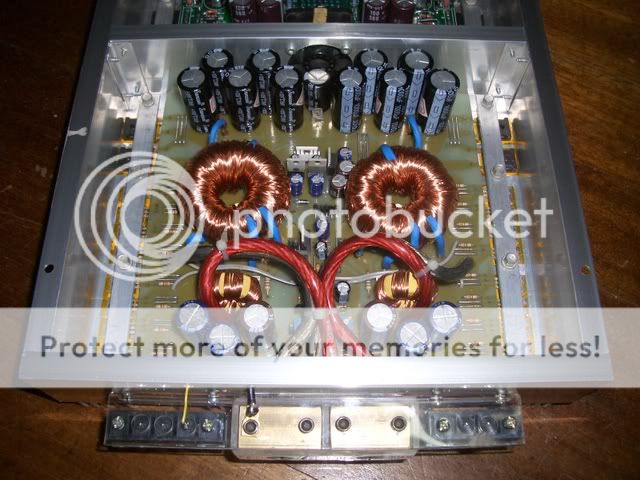
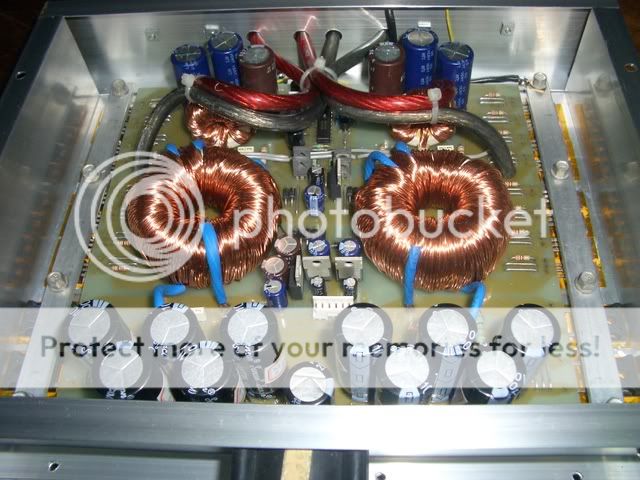
terminal blocks:
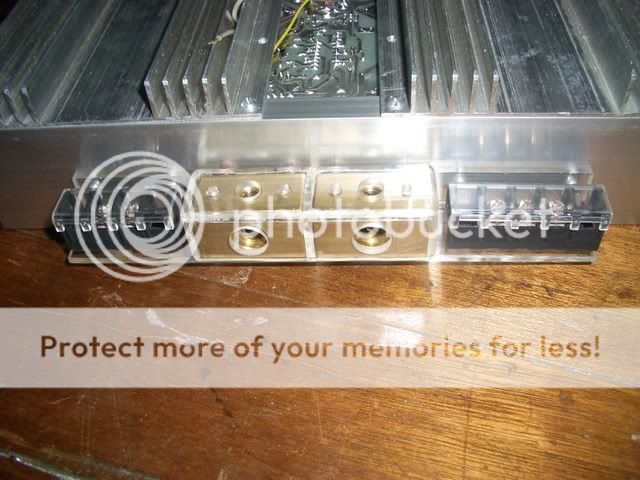

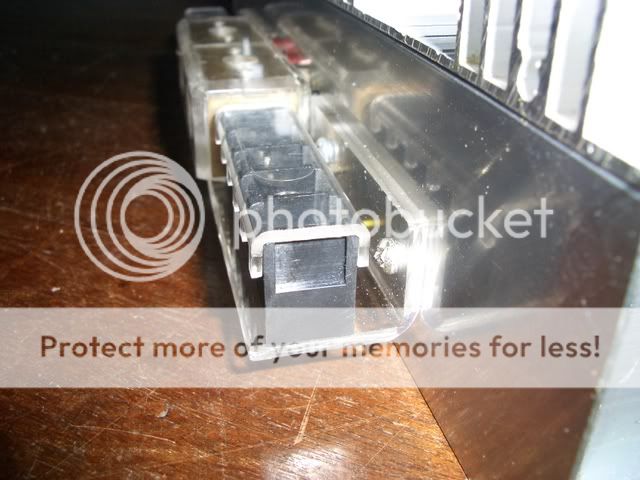
mounting of fets and rectifiers:
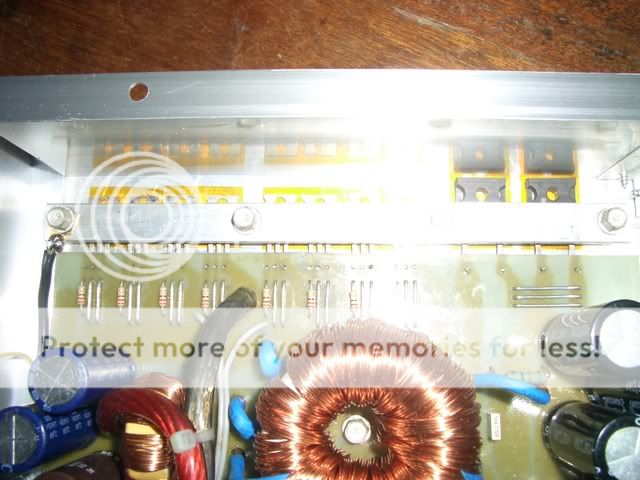
toroid mounting locations:
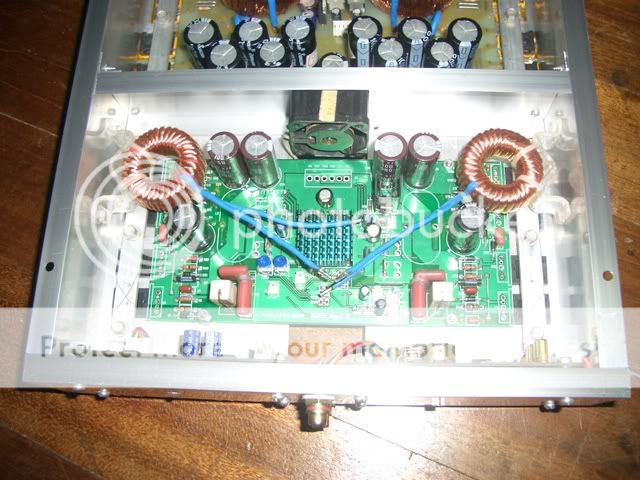
approximate look of completed amp:
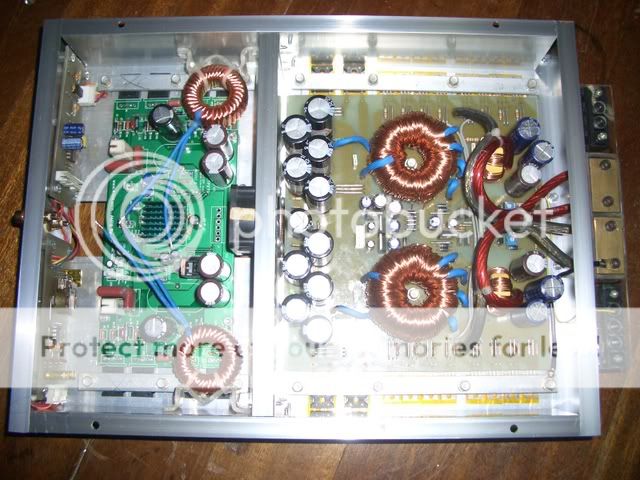
completed SMPS:


terminal blocks:



mounting of fets and rectifiers:

toroid mounting locations:

approximate look of completed amp:

BTW,
has anyone tested amp8 above +/-65volts? because I'm afraid of blowing up the driver chip. the chipset is rated at +/-70volts and the SMPS goes up to about +/-68.
how do the other tripath chips handle a bit of supply overvoltage?
has anyone tested amp8 above +/-65volts? because I'm afraid of blowing up the driver chip. the chipset is rated at +/-70volts and the SMPS goes up to about +/-68.
how do the other tripath chips handle a bit of supply overvoltage?
Hi
In mute it should hold up...And if you will test it in car, start with engine off, then on, but with lights on. This amp looks and means business 😀 nice job...
PS: that is a lot of wire 😀, do you happen to know how much that was, length?
In mute it should hold up...And if you will test it in car, start with engine off, then on, but with lights on. This amp looks and means business 😀 nice job...

PS: that is a lot of wire 😀, do you happen to know how much that was, length?
I hope it holds up. I'm having second thoughts if I would remove a turn off the trafo to drop the voltage a bit.
the voltage goes up to +/-68V when there is no load and input is about 14.5V just before the overvoltage trips and shuts the supply down.
how much wire? the amp now weighs a lot. 😀
each primary is about 14" long, the secondary is about 9feet. those are estimates BTW. never thought about measuring them before winding. hehe
the voltage goes up to +/-68V when there is no load and input is about 14.5V just before the overvoltage trips and shuts the supply down.
how much wire? the amp now weighs a lot. 😀
each primary is about 14" long, the secondary is about 9feet. those are estimates BTW. never thought about measuring them before winding. hehe
Hi
I think if you will do full test, do it with lights on, if worried still, take one turn off, but I think if you have another amp, voltage won't be that high to kill chip... Up to +/-70V you can go: Absolute Maximum Ratings indicate limits beyond which damage to the device may occur.
I think if you will do full test, do it with lights on, if worried still, take one turn off, but I think if you have another amp, voltage won't be that high to kill chip... Up to +/-70V you can go: Absolute Maximum Ratings indicate limits beyond which damage to the device may occur.
I have two other amps one for the front speakers and another for the rears. so that might take care of the voltage. 
only soldering the fets to the amp8 board and wiring them together is all that's left and then testing if it will run.
I was thinking of first testing it to its limits (input voltage only. I don't have a high current 12V supply) at the bench first.
run it up to max till the SMPS shuts down and see how it deals with restarting after a fault then install in car for power testing. hopefully I don't let the magic smoke out.

only soldering the fets to the amp8 board and wiring them together is all that's left and then testing if it will run.
I was thinking of first testing it to its limits (input voltage only. I don't have a high current 12V supply) at the bench first.
run it up to max till the SMPS shuts down and see how it deals with restarting after a fault then install in car for power testing. hopefully I don't let the magic smoke out.

Hi
Yes test it to its limits first, amp should mute if you have overvoltage set lower then 68v. I think everything will go as planed...
Please make video when you will test it in car, allway like to see DIY stuff brake things like speakers 😀
Yes test it to its limits first, amp should mute if you have overvoltage set lower then 68v. I think everything will go as planed...
Please make video when you will test it in car, allway like to see DIY stuff brake things like speakers 😀
Hey, I don't mean to take this offtopic, but i also want to build an amp8 but for home use.
a 1000va toroid will be extremely heavy, so how hard would it be to make a SPMS like you have done, but that runs from 240v instead of 12v?
Would it simply be a case of having 20 times less windings on one of the toroids?
a 1000va toroid will be extremely heavy, so how hard would it be to make a SPMS like you have done, but that runs from 240v instead of 12v?
Would it simply be a case of having 20 times less windings on one of the toroids?
nope. you will have to redesign the whole circuit.
I have built several SMPS's for car use but haven't had the guts to make an offline SMPS yet.
the risk of burning your house down or killing someone is possible when you don't have enough experience with those things.
I have built several SMPS's for car use but haven't had the guts to make an offline SMPS yet.
the risk of burning your house down or killing someone is possible when you don't have enough experience with those things.
Gotcha, I guess there's not really as much risk when running things from 12v as there is from 240v.djQUAN said:nope. you will have to redesign the whole circuit.
I have built several SMPS's for car use but haven't had the guts to make an offline SMPS yet.
the risk of burning your house down or killing someone is possible when you don't have enough experience with those things.
I don't really know much at all about doing your own SMPS, so I may just go with a toroid for now, and build or buy an SMPS later on. 🙂
Also, have you thought about putting a few high current schottkey diodes on yer PSU rails? each one should knock 0.5v or 0.7v off the rails which would result in less chance of ever giveing the AMP8 70+v.
 Just have say 5 in series for 2.5v drop. 🙂
Just have say 5 in series for 2.5v drop. 🙂EDIT: Just one more quick question, would it be very difficult to build a 25v psu that runs from 12v car battery? I would need around 10a of output current, so run an amp9 at full power in my car... If you know of any good links or info on where to start that would be great. I don't mind winding own toroids as I have loads and loads of solid copper wire. 🙂
I have thought about the diode trick but there is not much room to work with. 🙁
a small SMPS for amp9 is easy. there is a schematic in the power supply design forum somewhere. try to PM 'N-Channel' as he has made several of those converters already.
a small SMPS for amp9 is easy. there is a schematic in the power supply design forum somewhere. try to PM 'N-Channel' as he has made several of those converters already.
it's playing music!!!!!
here's how my workshop floor looks like right now.

how the fets are mounted


it's alive!!!!

some waveforms:
gate drive 5v/div

primary waveforms:
took that with the ground lead connected to chassis. don't know if that was causing the spikes. the heatsink stays cool. 10v/div

after the half bridge:
20v/div

the thing on the bench:

and then it blew!!! It was playing then I heard a very loud pop then the safety bulb in series with the supply glowed.
It was playing then I heard a very loud pop then the safety bulb in series with the supply glowed.

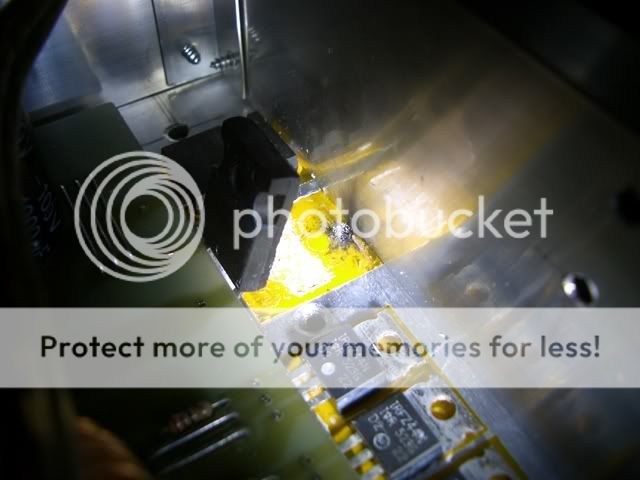
a metal flake must have gotten under the kapton tape.
the old chassis and boards:

here's how my workshop floor looks like right now.

how the fets are mounted


it's alive!!!!

some waveforms:
gate drive 5v/div

primary waveforms:
took that with the ground lead connected to chassis. don't know if that was causing the spikes. the heatsink stays cool. 10v/div

after the half bridge:
20v/div

the thing on the bench:

and then it blew!!!
 It was playing then I heard a very loud pop then the safety bulb in series with the supply glowed.
It was playing then I heard a very loud pop then the safety bulb in series with the supply glowed.

a metal flake must have gotten under the kapton tape.

the old chassis and boards:

- Home
- Amplifiers
- Class D
- Big-t